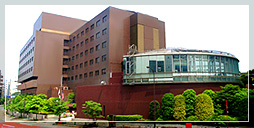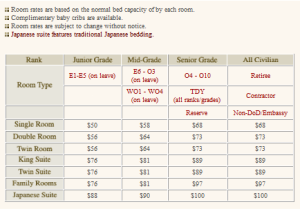Now There is a Military Resort in Japan
I think most Service Members are familiar with the standard four Armed Forces Recreation Centers (AFRC for short). They are all great deals for a resort hotel in very expensive areas. The four traditional hotels are:
– Edelweiss in the German Alps
– Shades of Green at Disneyworld
– Dragon Hill in Yongsan Garrison Seoul
– Hale Koa in Waikiki, Hawaii
I have stayed in all of these with my family except the Shades of Green. They are all great and you stay there at a rate based upon your rank making it affordable for even the lowest enlisted. The good news is that there is now a fifth site in Tokyo, Japan. While I haven’t been there, I would hope to give it a try. Here is their web page, which you will not discover from the main AFRC page, so I think most will not have discovered this hidden gem yet. Called the New Sanno, here is a great blurb from their website describing the property:
Want an American-style MWR oasis in downtown Tokyo at a reasonable price? You have only one choice. The New Sanno Hotel, situated in the heart of the world’s most expensive city, offers 149 luxurious rooms. Available to I.D. card holders and their guests, The New Sanno offers a variety of accommodations and restaurants in a helpful, English-speaking environment.
Here is a table of their rates:
Reading the description, I really want to try the Japanese Suite! I have no plans to get there any time soon, but if anyone else does, please let us know what you think of the property. The rates shown are probably a third of what you would need to pay if you stayed on the economy and I doubt you need to worry about currecy fluctuations. If anyone has stayed here, please give us a review.



Great post, but the New Sanno is not a new military resort at all. Not sure how long ago it opened, but I stayed at it repeatedly in the late 80s. Pretty good location, GREAT price, GREAT tour desk if interested, EXCELLENT authentic (i.e. not dumbed down) Japanese restaurant on premises as well as a post office and NEX (or AAFES?) outlet.
Highly recommend this.
Only minor drawbacks…. like any Tokyo hotel it’s a little tough/expensive to get to from airport(s), but once you have shedded your baggage at the hotel the subway is not far away
We also stayed at the Sanno in 1985, my last year of service. I was a Dental officer for three years. Ironically there was a military dental conference during our stay there. Rooms were tough to come by and from one night to the next we didn’t know if we were going to have a room. We stayed in the Japanese suite and the Admirals Suite as it was the only room available that night due to the conference!
Stayed there a few times in the last few years. I certainly wouldn’t consider this to be a resort…rather, a good deal in an expensive city. Agree with the first poster on the difficulty in getting to the place and its relative inaccessibility…subway is an 8 minute walk or so. Also, room availability can be a challenge as they’re often booked up.
@ Ari – Yeah, the label “resort” is applied liberally by both the MWR and many hotel chains. The Dragon Hill in Korea is pretty much just a hotel, for example, but thanks for the feedback.
The washitsu (Japanese Room) is nice, as is the regular suite. The regular rooms are adequate. I should mention that if the Sanno is fully booked, Hardy Barracks (a stone’s throw from Roppongi) also has MWR Army Lodging, albeit no pool, restaurant, or any hotel-worthy amenities.
Non-military, so I can only comment on my accompanied trips to the New Sanno Hotel…
It’s definitely not new. If they’ve re-branded as a resort, great for them. If you’ve been in Japan for a while, and you’re looking for an AWESOME hamburger, the New Sanno has really wonderful hamburgers (although there’s a lot more hamburger places, including Kua Aina, all over Tokyo now). Of course, you need to either be military, diplomatic, or be accompanied.
Judging from the picture, it does look like they remodeled, so it might be a “resort-style” property now.
Mmmm, Kua Aina. Hard for me to imagine a better burger than that! I ate there all the time when I lived in Honolulu. I can’t imagine what all that beef must cost in Japan.
@Paul v: Regarding the transportation to the hotel, the most time/cost effective way to get there in my opinion is as follows: Purchase a SUICA+NEX round-trip set at Narita Airport for 5000 yen. Because it comes with a 2000 yen SUICA prepaid IC card (loaded with 1500 yen; you get 500 yen back when you return the card to JR) which you can use to purchase things at quite a few retail outlets, it costs effectively 1750 yen each way to go from Narita to Shinjuku or Tokyo Station and back-not bad considering the distance-taxis from Narita are NOT an option price wise. Included in your ticket is the option to take the local commuter JR train to any JR station in the 23-Ward (City) Downtown Tokyo area. Once you arrive at Shinjuku Station, take either the Yamanote or Saikyo line train to Ebisu Station (5 stops on the Yamanote; 2 stops on the Saikyo). Important Note: You must have a non-Japanese passport (presumably with a tourist visa stamp) to be eligible for the SUICA-NEX deal. From Ebisu Station it’ll cost you about 700-900 yen to take a taxi to the New Sanno. The New Sanno website has a map, which I recommend you print out to show to the taxi driver. There are several options for reduced price tickets for the Tokyo Metro Subway Line as well (One Day Pass, Off-Peak/12 for the price of ten, Multiple Trip/11 for the price of 10). I don’t recommend using Multiple Trip tix for any train line other than Tokyo Metro because it’s the only one where, if you go outside the 160 yen zone, you simply pay the difference. Other train lines have point A to point B Multiple trip tix, but will charge full fare if you go past point B to a station beyond it.
@glenn: Beef there is either very expensive or very cheap, depending on the country of origin. Japanese beef (Waygyu) tends to be very pricey; imported beef from the US or Australia (which a lot of chain restaurants use) is fairly cheap considering tipping is not required in Japan. Final Note: Larger chain retail outlets will knock off the Consumption (Sales) Tax (8% starting April 1st) on merchandise purchases over 10,000 yen if you show your passport with a tourist visa stamp. For electronic stores, this may not be as good as getting points on their loyalty card if the discount is over 8% (no double-dipping allowed), so be sure to ask. Generally, electronics with global warranties (i.e beyond Japan) cost more than the domestic equivalent, and are usually items available in the US for a lower price. So if you want the “only available in Japan” stuff, be prepared to stuck with a Japan-only warranty.
@ Mark – Wow! Nice to hear from an obvious expert!
Just a little more info…..(I really should start a blog on Japan travel) The Japanese restaurant at the Sanno (Kikuya)is in my opinion overpriced and underwonderful. Go to an Izakaya (Japanese pub serving tapas-style dishes and shared plates) instead for a more authentic Japanese dining experience. There’s a chain Izakaya near Hiro-o station (closest subway stop to the Sanno) with English menus, and because of the higher than average concentration of foreigners in the Hiro-o/Azabu area (near the New Sanno), English menus are much more likely than in other parts of Tokyo. Final note (redux): Japan has not completely warmed up to the idea of using credit cards, and most ATM machines do not accept cards issued outside Japan. Make sure you have enough cash for emergency situations. In a pinch, the ATMs for Japan Post, Citibank, Shinsei Bank, and 7-11 will take foreign cards – most other banks will not. AMEX users should expect “Call Center” situations at many retail outlets which can take more time than you’d prefer – It’s kinda a Japan thing. Alibi – If you’re staying at Hardy Barracks and you’re getting there by taxi, tell the driver “Seijokki Shinbun Biru (Stars and Stripes Newspaper Building). The term Hardy Barracks is not the preferred term in Japanese, as the Hardy Barracks building is much smaller than the largest building on post – The Pacific Stars and Stripes Newspaper Building. If you have Google Maps, show the driver and use the Mori Building as your point of reference; a US Military base in Downtown Tokyo sticks out like the sore thumb most of the locals think it is.
Please send me information and phone or address to make reservations
@ Judy-Just go to http://www.thenewsanno.com and you should find all the information you need.